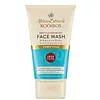Nivea Gentle Cream Wash Versus African Extracts Rooibos Skin Care Purifying Deep Cleansing Gel Face Wash
What's inside
What's inside
 Key Ingredients
Key Ingredients

 Benefits
Benefits

 Concerns
Concerns

 Ingredients Side-by-side
Ingredients Side-by-side

Water
Skin ConditioningIsopropyl Palmitate
EmollientGlycerin
HumectantCaprylic/Capric Triglyceride
MaskingCetearyl Alcohol
EmollientCetyl Alcohol
EmollientButyrospermum Parkii Butter
Skin ConditioningGlyceryl Stearate
EmollientGlyceryl Stearate Citrate
EmollientMethylpropanediol
SolventPrunus Amygdalus Dulcis Oil
Skin ConditioningXanthan Gum
EmulsifyingSqualane
EmollientDecyl Glucoside
CleansingMannitol
HumectantMicrocrystalline Cellulose
AbsorbentEthylhexylglycerin
Skin ConditioningHydroxyacetophenone
AntioxidantAlgin
MaskingTalc
AbrasivePhenoxyethanol
PreservativeParfum
MaskingCI 73360
Cosmetic ColorantWater, Isopropyl Palmitate, Glycerin, Caprylic/Capric Triglyceride, Cetearyl Alcohol, Cetyl Alcohol, Butyrospermum Parkii Butter, Glyceryl Stearate, Glyceryl Stearate Citrate, Methylpropanediol, Prunus Amygdalus Dulcis Oil, Xanthan Gum, Squalane, Decyl Glucoside, Mannitol, Microcrystalline Cellulose, Ethylhexylglycerin, Hydroxyacetophenone, Algin, Talc, Phenoxyethanol, Parfum, CI 73360
Water
Skin ConditioningSodium Laureth Sulfate
CleansingCocamide DEA
EmulsifyingCocamidopropyl Betaine
CleansingSorbitol
HumectantSodium Chloride
MaskingDecyl Glucoside
CleansingPEG-120 Methyl Glucose Dioleate
EmulsifyingAdansonia Digitata Fruit Extract
EmollientAspalathus Linearis Leaf Extract
Skin ConditioningCitric Acid
BufferingLaureth-4
EmulsifyingDisodium EDTA
Cocamidopropyl Dimethylamine
EmulsifyingSalicylic Acid
MaskingPhenoxyethanol
PreservativeCaprylyl Glycol
EmollientSodium Hydroxide
BufferingSodium Metabisulfite
AntioxidantParfum
MaskingAlpha-Isomethyl Ionone
PerfumingLimonene
PerfumingLinalool
PerfumingWater, Sodium Laureth Sulfate, Cocamide DEA, Cocamidopropyl Betaine, Sorbitol, Sodium Chloride, Decyl Glucoside, PEG-120 Methyl Glucose Dioleate, Adansonia Digitata Fruit Extract, Aspalathus Linearis Leaf Extract, Citric Acid, Laureth-4, Disodium EDTA, Cocamidopropyl Dimethylamine, Salicylic Acid, Phenoxyethanol, Caprylyl Glycol, Sodium Hydroxide, Sodium Metabisulfite, Parfum, Alpha-Isomethyl Ionone, Limonene, Linalool
Ingredients Explained
These ingredients are found in both products.
Ingredients higher up in an ingredient list are typically present in a larger amount.
Decyl Glucoside is a glucose-based surfactant and emulsion stabilizer. It is created by reacting glucose with the fatty acids from plants.
Surfactants help clean the skin by trapping oil, sebum, and dirt to be washed away. As an emulsion stabilizer, it stabilizes the ingredients in a product by preventing them from separating.
This ingredient is biodegradable and non-toxic. This ingredient is commonly found in baby shampoos.
Decyl Glucoside is sometimes used to stabilize the UV filter Tinosorb.
Learn more about Decyl GlucosideParfum is a catch-all term for an ingredient or more that is used to give a scent to products.
Also called "fragrance", this ingredient can be a blend of hundreds of chemicals or plant oils. This means every product with "fragrance" or "parfum" in the ingredients list is a different mixture.
For instance, Habanolide is a proprietary trade name for a specific aroma chemical. When used as a fragrance ingredient in cosmetics, most aroma chemicals fall under the broad labeling category of “FRAGRANCE” or “PARFUM” according to EU and US regulations.
The term 'parfum' or 'fragrance' is not regulated in many countries. In many cases, it is up to the brand to define this term.
For instance, many brands choose to label themselves as "fragrance-free" because they are not using synthetic fragrances. However, their products may still contain ingredients such as essential oils that are considered a fragrance by INCI standards.
One example is Calendula flower extract. Calendula is an essential oil that still imparts a scent or 'fragrance'.
Depending on the blend, the ingredients in the mixture can cause allergies and sensitivities on the skin. Some ingredients that are known EU allergens include linalool and citronellol.
Parfum can also be used to mask or cover an unpleasant scent.
The bottom line is: not all fragrances/parfum/ingredients are created equally. If you are worried about fragrances, we recommend taking a closer look at an ingredient. And of course, we always recommend speaking with a professional.
Learn more about ParfumPhenoxyethanol is a preservative that has germicide, antimicrobial, and aromatic properties. Studies show that phenoxyethanol can prevent microbial growth. By itself, it has a scent that is similar to that of a rose.
It's often used in formulations along with Caprylyl Glycol to preserve the shelf life of products.
Water. It's the most common cosmetic ingredient of all. You'll usually see it at the top of ingredient lists, meaning that it makes up the largest part of the product.
So why is it so popular? Water most often acts as a solvent - this means that it helps dissolve other ingredients into the formulation.
You'll also recognize water as that liquid we all need to stay alive. If you see this, drink a glass of water. Stay hydrated!
Learn more about Water